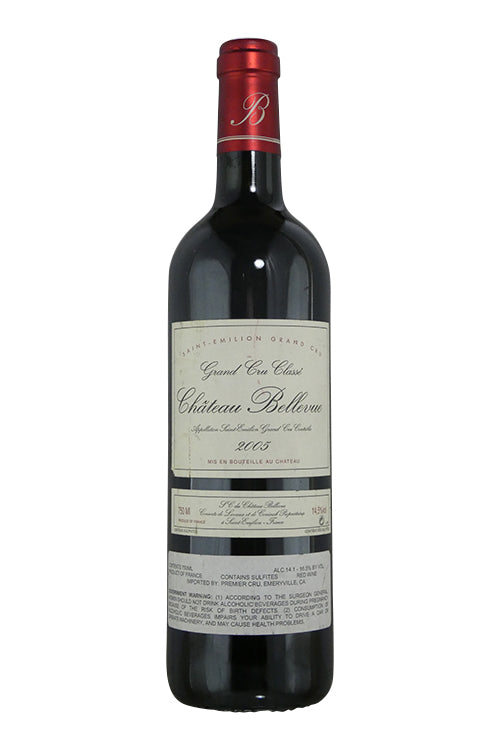1
/
of
1
Chateau Bellevue St. Emilion Grand Cru - 2005 (750ml)
Chateau Bellevue St. Emilion Grand Cru - 2005 (750ml)
Regular price
$149.99
Sale price
$149.99
Regular price
$149.99
Unit price
/
per
The first bottle of 2005 Bellevue that I tasted had a maderized, oxidized nose that was off-putting. This note is from a second bottle. This second bottle showed absolutely no trace of oxidation, but did offer plenty of crushed, chalky minerality, notes of plum, blueberry, black raspberry and cherry fruit, a dense purple color, a full-bodied mouthfeel, and fabulous structure, purity and length. It should drink well for at least another 20+ years.
Robert Parker - 94 points
Robert Parker - 94 points
Share :

- varietal
- Region
- Sub - Region
- Type
- Reviews
Product Review
The first bottle of 2005 Bellevue that I tasted had a maderized, oxidized nose that was off-putting. This note is from a second bottle. This second bottle showed absolutely no trace of oxidation, but did offer plenty of crushed, chalky minerality, notes of plum, blueberry, black raspberry and cherry fruit, a dense purple color, a full-bodied mouthfeel, and fabulous structure, purity and length. It should drink well for at least another 20+ years.
Product Score
94
Cabernet Sauvignon is one of the most prominent dark-skinned grape varieties except Merlot in terms of area under vines, but which comprises our largest selection of wines. Grown in just about every wine producing region and climate, Cabernet Sauvignon can express a huge range of aromas, from green peppers in cool climates through to dark jammy fruit in hot regions. Common aromas include blackcurrants, mint, graphite, and forest floor, to name a few. Maturation in small oak barrels can develop a complex range of aromas from cedar wood, cigar box and tobacco to eucalyptus and undergrowth. Cabernet Sauvignon’s success is partly due to its ability to adapt to a range of soils and climates. It is the main constituent of the Bordeaux blend in the revered communes of Pauillac, St. Estephe and St. Julien, and has achieved equal success in California’s Napa Valley. It is grown extensively throughout Southern Australia, with some outstanding examples from the Terra Rossa soil of Coonawarra. Cabernet Sauvignon also plays an increasing role in Tuscany, Italy, where it is blended with native varieties such as Sangiovese to produce the Super Tuscans.
Located in South West France, Bordeaux is one of the World’s most important wine producing regions. The Gironde estuary and its two tributaries, the Garonne and Dordogne, splits the region into the ‘left bank’ and ‘right bank’. The left bank, on the west side of the Gironde, consists of the Médoc and Graves, while Pomerol and St. Emilion are located on the right bank. In between the Garonne and Dordogne is the Entre-Deaux-Mers region, French for 'between two seas'. From north to south the Médoc includes the famous classed growth chateaux in the communes of St. Estephe, Paulliac, St.Julien, and Margaux. The Graves and it’s enclave Pessac-Léognan make both red and white wine. While those of Pessac- Léognan’s are dry, Sauternes and Barsac make world-famous sweet whites. Although Bordeaux makes some of the world’s most expsenive wines, less expensive but good value alternatives come from Moulis and Listrac on the left and Bourg and Blaye on the right offer less expensive wines for earlier consumption.
St. Emilion is the largest of Bordeaux’s right bank appellations, however unlike the grand estates of the Medoc, it is composed of hundreds of small producers, also referred to as garagistes. Merlot and Cabernet Franc dominate with the former accounting for about 60% of all plantings. Some Cabernet Sauvignon is grown, however careful site selection is important as the soils are generally too warm. While the Medoc (left bank) was ranked under the official 1855 classification, it wasn’t for another hundred years until the St. Emilion rolled its own. Where the 1855 classification has only been changed three times, St. Emilion’s, by comparison, is far more dynamic, with a new list drawn up everything ten years. However, as the 2006 classification demonstrated, changes, particularly when producers are demoted, are fiercly contest. Finally passed by the legislature in 2009, the classification comprised of 15 Premier Grand Crus classes and 53 Grands crus classes. The Premiers are broken down further into two groups classes A and B, with Châtea Ausone and Châtea Cheval Blanc in the former and the remaining 13, including such revered producers as Château Angélus, Château Pavie, and Château Figeac, in the latter.
Red wine is wine made from dark-coloured grape varieties. The color of red differs based on the grapes variety or varieties used.Interestingly, black grapes yield a juice that is greenish-white. The actual red color comes from anthocyan pigments (also called anthocyanins) from the skin of the grape (exceptions are the relatively uncommon teinturier varieties, which produce a red colored juice). Most of the production centers around the extraction of color and flavor from the grape skin.


